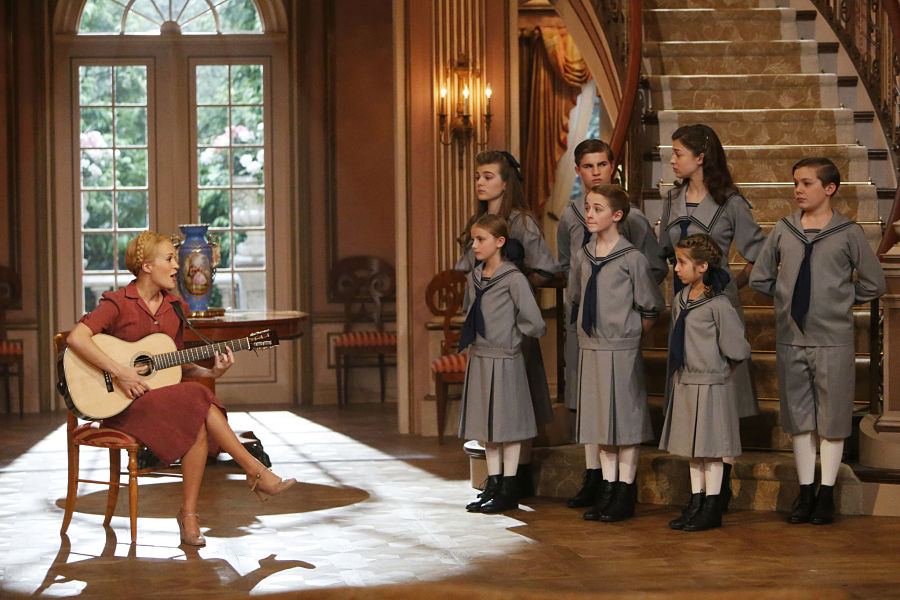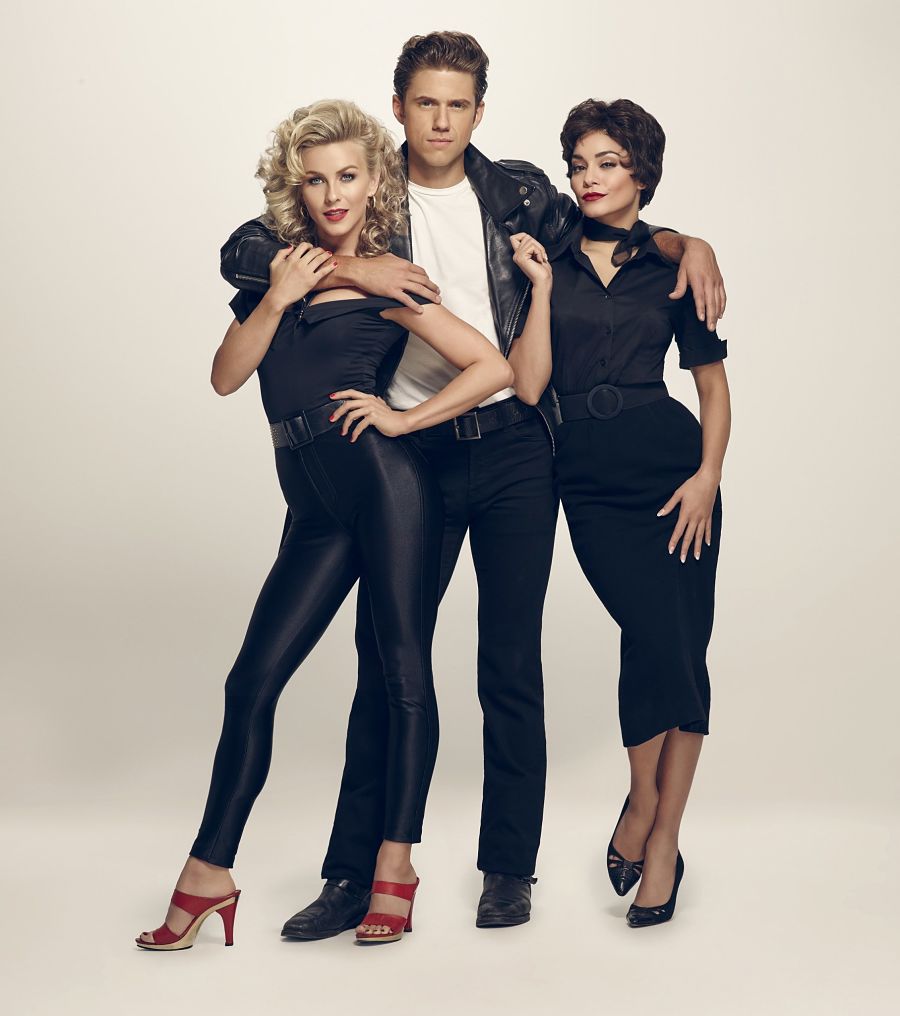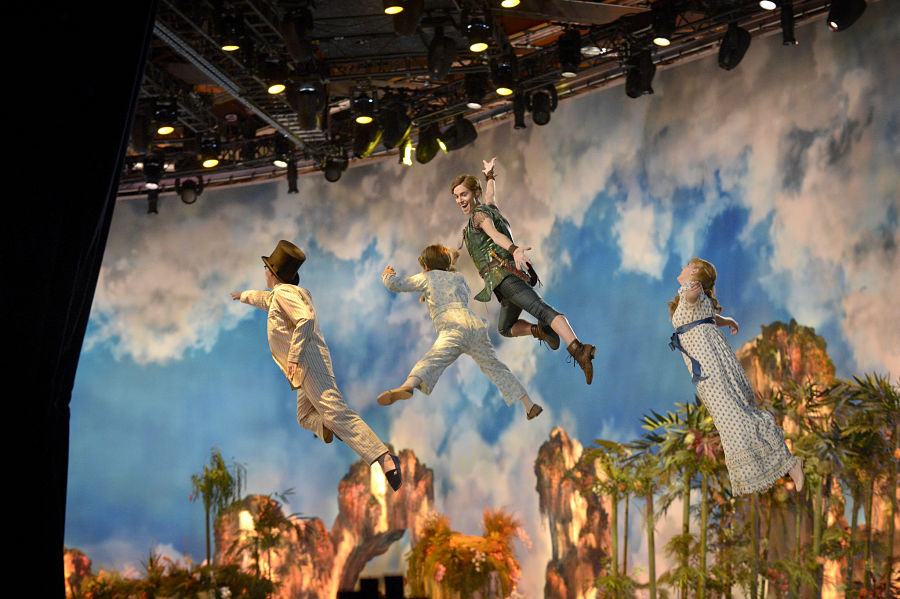Remember the days when friends and family would gather around the television—or even the radio—at the same hour to catch their favorite programs together? Me neither. In the age of DVRs and Netflix, television has become a more atomized entertainment experience, less a save-the-date appointment event than a midnight snack (or a binge).
Theatre, on the other hand, remains the very definition of “you had to be there.” Each night a different performance—even of the same show—lights up the stage. Actors could flub lines, miss cues, or anything; you never know. If you’re not there, then you’ll miss it.
Of course, what TV still has that theatre lacks is a wide audience, or at least portability. Might these two forms learn a thing or two from each other? Looks like they are, as we seem to be in a new age of live musical broadcasts on network television, in particular NBC, which aired “The Sound of Music Live!” in 2013, followed by “Peter Pan Live!” in 2014. Next up on NBC is “The Wiz Live!” on Dec. 3. With the entrance of a new player, Fox, which will broadcast “Grease: Live” on Jan. 31, 2016, it’s safe to call this a bona fide trend.
“Big network viewership was trending downwards, and we examined the landscape,” explains Neil Meron, who with his producing partner Craig Zadan has produced all three of the NBC events. “The sports events and awards shows were the only things that were holding and growing audiences, and one of the reasons for that is that they were live. We were thinking possibly that a live musical would be the way to go next, which is kind of callback to the way they were done in the 1950s.”
Back then, shows like CBS’s “Playhouse 90” and NBC’s “Kraft Television Theatre” broadcast live drama, written by the likes of Horton Foote, though by 1957 “Playhouse” had begun taping its broadcasts; it ended in 1960. Even Rodgers & Hammerstein got in on the act with Cinderella, written specifically for live broadcast on CBS in 1957. There have been sporadic attempts to recapture that magic since—remember George Clooney’s 2000 live-TV staging of Fail Safe, or the time in 1997 when “ER” broadcast an entire episode live? But apart from sketch-comedy mainstays like “Saturday Night Live,” television has primarily been a taped medium.
Meron and Zadan had already ventured into remaking musicals for primetime network TV with such efforts as 1993’s Gypsy with Bette Midler, 1997’s Cinderella with Brandy, and a 2003 version of The Music Man with Matthew Broderick and Kristin Chenoweth. (They also produced Hairspray and Chicago for the big screen, winning a Best Picture Oscar for the latter.)
It was when Robert Greenblatt, chairman of NBC Entertainment, approached Meron and Zadan with the idea of a TV movie of Oklahoma! that they countered with the idea of a live Sound of Music. Greenblatt signed on. “The Sound of Music Live!” cast country singer Carrie Underwood in the lead, alongside theatre vets like Audra McDonald and Laura Benanti; though there was a memorably bitchy response on Twitter, the broadcast drew an impressive 22 million viewers. (Zadan recalls that he and Meron were advised not to take the ratings seriously when they first came in because they would need to be rechecked; they were correct.)
Their next effort, “Peter Pan Live!,” was less successful, drawing just 9 million viewers (and plenty of Twitter snark). Zadan blames it on casting; though they had Christopher Walken as Hook and Allison Williams as Peter Pan, as well as theatre performers like Kelli O’Hara, Zadan laments, “Without names like Carrie Underwood, people would not tune in to the same extent.”
For “The Wiz Live!,” they’re taking no chances: Queen Latifah plays the title role, with Mary J. Blige as Evilene and Ne-Yo as the Tin Man. Theatre and TV vets include Uzo Aduba as Glinda and Amber Riley as Addaperle. In a new development that takes the show back to its stage roots, Meron and Zadan plan to mount The Wiz live, as well: The show is slated for Broadway during the 2016-17 season. “All of the elements in the show could either be directly brought over to the theatre or adapted to the theatre,” explains Meron.
Adds Zadan, “Let’s say The Wiz is successful on TV and then goes to Broadway and is successful on Broadway—that will be the first time that the TV show was a commercial.” It’s not entirely without precedent, he adds, noting that performance-based shows like “Glee” birthed a lucrative national concert tour, and that both of the show-within-a-show properties from the TV show “Smash” (Hit List and Bombshell) have had live renditions.

Of course, both The Wiz and Grease have wide name recognition in part thanks to popular film versions. And since Paramount Television is producing “Grease: Live,” the writers for the live broadcast, Jonathan Tolins and Robert Cary, are basing their version on screenplay rather of the stage show’s book. (Paramount Pictures produced the 1978 film.) Their challenge is to take the film version of Grease, the stage show, and any subsequent editions—school versions, Broadway revivals that incorporated bits of the movie—and create something cohesive.
“Our job is to create this new version that keeps in everything people remember and love and would miss, but also make sure it works in the technical parameters of this particular three-hour television extravaganza,” says Tolins.
The original film is a little under two hours long, and Tolins and Cary have to come up with two hours and 15 minutes of material for the broadcast. That means they’ll incorporate numbers from the original stage show, and possibly scenes from the screenplay that were cut from the film.

Formatting the story for network television rather than either stage or film has also been a challenge, though. For one thing, movies and theatre don’t have commercial breaks. Instead of writing the standard two parts broken by an intermission, as they might for the theatre, Tolins and Cary have to break the script into a lot of mini-acts.
“It goes from a simple two-act structure to many more discrete segments that feel like they have to have their own satisfaction to take you into commercials,” Cary explains. “You also don’t want to have three acts in a row to be devoted to one pair of principals only to have the next two devoted to another; you want to create a satisfying checkerboard.”
Harvey Fierstein, who is writing the teleplay for “The Wiz Live!,” has had a similar experience. “With a piece like The Wiz, which is very episodic, commercials were pretty easy to plan,” Fierstein says. “The trick is to use the commercial breaks as punctuation or to enhance the dramatic arc. Also, since we don’t have a live audience to react at the end of musical numbers, the commercial breaks can provide the viewing audience with the emotional and physical release that applause would normally provide in a theatre.”
Not having a live audience has also affected how Fierstein has crafted the comedy for the live broadcast, as many of the jokes in the stage version are designed to play off an audience reaction. “Without laughter, the actors delivering those broad jokes would be left standing with the proverbial egg on their faces,” adds Fierstein. “There is a difference between the way jokes are written for TV presented with or without studio audiences and laugh tracks. Since we will have no studio audience and no laugh track, we had to make adjustments.”
Other technical considerations include accounting for costume changes and making sure the characters can get from one sound stage to another (there will be three for “Grease: Live”) in time for the next scene. That’s where theatre thinking comes in handy.
“It would play in the way that live things play,” Cary explains. “Obviously, there’s going to be close-ups and there’s going to be tracking shots and things that give a film its excitement. But the values of theatre—in terms of its satisfaction and the energy of it and the humor of it— are what drive us.”
Since a Broadway revival is already slated, many of the elements of “The Wiz Live!” are being designed more for a theatre than a soundstage. Set designer Derek McLane has designed the sets for all three NBC broadcasts so far, with “Sound of Music Live!” consisting of separate soundstages with proscenium-style set-ups and “Peter Pan Live!” existing as separate 360 environments.
With “The Wiz Live!,” however, McLane’s mandate was to create sets that could also reasonably live in a Broadway theatre for the revival. The problem is, a television soundstage is built very differently from a Broadway theatre. The latter typically has a lot of fly space and minimal wing space, whereas Grumman Studios, where “The Wiz Live!” will film, has the reverse: no height for drops but a large amount of lateral space. So backdrops, which would fly in in a theatre, will instead have to track in from the side for the live broadcast.
And while other live broadcasts have been able to seamlessly cut between environments with different soundstages, “The Wiz Live!’s” scene transitions will have a theatrical quality. The broadcast will have an LED wall as the backdrop—something McLane isn’t sure will make it to Broadway—to help animate these transitions.
“It’s a bit of a hybrid,” McLane explains of the set. “There is certainly more detail in parts of the set than there would be for a Broadway set, just because we know we’re going to see parts of it close up. I knew if we were going to make this a Broadway production, there was no way we could adapt a TV set for Broadway.”

These live television broadcasts have also created new hybrid models of collaboration. “Grease: Live” has two directors: a theater director, Thomas Kail (Hamilton), and a live broadcast director, Alex Rudzinski, known for his work on “Dancing With the Stars.”
“Coming to the table on Day One, we were both a little nervous and had questions for each other—it’s a synergy and a partnership we weren’t used to,” Rudzinski explains. “In terms of the rehearsal process, Tommy and I will share as much as possible. I will watch Tommy’s direction of the actors; I’m there to support him and I’m there to offer advice on camera blocking and angles and actor blocking. The two of us work very closely with the choreographer, as well, in terms of creating that visual palette. To a degree, I’m secondary in the initial rehearsal stages, and then it sort of switches in the two or three weeks when we get to on-camera rehearsals.”
For Kail, the process so far has had a lot of similarities to his work directing for theatre. “It feels much more the same than it feels different,” Kail explains. “When you’re making a piece of theatre, the relationship with the choreographer and the lighting designer is very similar to your relationship with your director of photography. When you point the camera, you have that much more control, so that part is like speaking a language that you’re fluent in but it might be a slightly different dialect.”
Says Kenny Leon, who is directing “The Wiz Live!” as well as the upcoming Broadway revival, “The process of working with actors is always the same: having them look for the truth,” he explains. “It is a hybrid. You have to find the truth in the script, but you also have to prepare for television shots.”
Kail has some experience writing for live television—he and Lin-Manuel Miranda have written material for the Tony Awards—while his experience with the improv rap performance group Freestyle Love Supreme has given him the ability to think on his feet in a live environment. He’s most excited, though, about the potential reach of his work.
“It felt to me like this was a chance to try to do something that I believe in, which is make theatre for everybody, and television is the great popular medium right now,” says Kail.
Well, that and Twitter.


